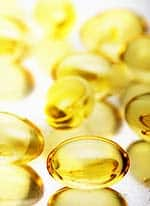Life Extension Magazine®
Suppose you could assess with precision your personal risk for sudden cardiac death—then reduce it substantially in a matter of weeks. You would be able to take immediate steps to lower your risk of sudden heart attack, without the need for drugs. You would even be able to determine whether the steps you’ve taken to induce favorable physiological alterations in your body have been effective and adjust them accordingly. Thanks to a team of pioneering scientists, this improbable medical scenario is now a reality. Just as hemoglobin A1c provides a snapshot of long-term glucose intake to assess diabetes risk, a revolutionary omega-3 index now provides a clear picture of the percentage of EPA/DHA omega-3 fatty acids in your blood to estimate your risk of a major cardiac event, including sudden cardiac death, heart attack, and fatal ischemic heart disease. In this article, you will learn about Omega Score™, a novel analytic technology that assesses multiple markers of cardiovascular disease risk. You will discover how a revolutionary, low-cost at-home blood test may furnish you with a tailored assessment of how much omega-3 is in your whole blood, serum, and red blood cells. You also will find out how to adjust your omega-3 supplementation for optimal cardiovascular protection. Optimal Cardiac DefenseNo cardioprotective dietary interventions have received more clinical validation than EPA and DHA.1-5 These widely recognized essential omega-3 fatty acids (derived from marine sources, primarily algae and fish) have been shown to safely suppress pro-inflammatory cellular signaling molecules and enzymes implicated in virtually all facets of cardiovascular disease and mortality, including:
Through these and other multi-targeted mechanisms of action, EPA and DHA provide virtually unrivalled heart health defense. They can prevent and even reverse cardiovascular disease by increasing levels of artery-cleansing HDL in the blood.14 They reduce harmful triglyceride and very-low density lipoprotein (VLDL) cholesterol levels. They have also been shown to slow disease progression and reduce mortality in aging humans already afflicted with cardiovascular disease, and to prevent sudden cardiac death in people previously without symptoms.1,2,15-17 While sufficient dietary intake of these essential fatty acids is crucial, researchers have further established that it is the ratio of omega-3 to less desirable omega-6 fatty acids—not their total concentration in the red blood cell membrane—that correlates with cardiovascular disease risk. The higher the amount of omega-3 relative to omega-6 in an aging individual’s total fatty acid composition, the greater the benefit, and vice versa.18 But not everyone metabolizes essential fatty acids in a reliable fashion. A host of factors may affect the actual levels of these important nutrients in whole blood and red blood cell membranes, resulting in widespread variation in those levels. In other words, simply eating a healthy diet, or even supplementing with health-promoting nutrients, often may not confer the benefits you are hoping for if your body isn’t processing the nutrients efficiently. Some people may require more, while others might get by with less supplementation. This may be one reason why, despite the widely publicized benefits of EPA and DHA, nearly 100,000 Americans died from omega-3 deficiency in 2009.19,20 In fact, a study published in 2009 ranked omega-3 dietary deficiency among the top ten preventable causes of death.19 Many times that number will likely suffer debilitating heart attacks, strokes, and neurological or cognitive damage as a result of sub-optimal omega-3 status.21-24 Determining Individualized Cardiovascular Disease Risk: The Omega Score™Increasing EPA and DHA intake may increase omega-3 in cell membranes and circulating lipids, while simultaneously lowering the concentration of less beneficial omega-6 fats.1,25 However, there has been no simple way for aging individuals to determine with precision whether they have actually attained an optimal omega-3 to omega-6 ratio in their own bodies. Until now.
The Omega Score™ was developed by Bruce Holub, PhD, and a private research group. It combines cutting-edge analytic technology with clinically validated measures that correlate established risk factors for cardiovascular disease to the lipid composition of human blood. The results are obtained from a simple finger stick blood sample you do at home, then simply send in your sample to the lab. Omega Score™ results provide a complete profile of an individual’s whole-blood fatty acid composition. This is known as the omega-3 index. Using these results, specific scores and ratios are calculated automatically. They are then correlated with known risk factors for various kinds of cardiovascular disease, based on the most recent scientific research. As you may know, recent research suggests that omega-3 levels may be among the best predictors of future coronary heart disease, providing stronger correlations to the risk of sudden cardiac death than traditional indicators. With this information in hand, you can estimate your own cardiovascular risk profile and monitor changes in your risk status as you adjust your omega-3 intake along with other lifestyle changes.
Dr. Holub’s breakthrough technology began with the simple insight that measurements of omega-3s in the blood correlate with cardiovascular risk in a number of striking ways. He knew from the scientific literature that it is the relative contribution of each fatty acid (as a percent of total fats) that is vital in cardiovascular disease risk calculation, as opposed to the absolute concentration of any one fatty acid.26-28 Holub realized he could use this information to construct customized risk profiles that would be specific to each individual—without the need for time-consuming and expensive blood draws and lab analysis. For example, Holub knew that the risk of coronary heart disease was 34% lower in men who had DHA percentages significantly greater than the population mean, and 31% lower for those whose total omega-3 percentages were significantly greater than the mean.18,29,30 Older adults whose total EPA plus DHA percentages were significantly higher than the population mean had a 70% reduction in risk of fatal heart attacks.31 Studies in the scientific literature had validated the idea that measurement of serum fatty acid composition could be used in assessing both intake of omega-3s and overall cardiac risk.27,32-34 In late 2009, Dr. Holub and colleagues published their own study, demonstrating that they could accurately assess cardiovascular disease risk based on the ratios of various omega-6 and omega-3 fatty acids in a very large sample of subjects.18 The strong correlation between these ratios and cardiovascular risk provided them with another valuable tool for assessing an individual’s cardiovascular status. Dr. Holub and his colleagues realized that their own work as well as that of other researchers now provided sufficient information to develop a comprehensive cardiovascular risk assessment tool. The following test parameters are included in the Omega Score™ blood test. Risk of Sudden Cardiac DeathYour risk of sudden cardiac death can be estimated from the Omega-3 Whole Blood Score, which measures omega-3 fatty acid content as a percentage of your total whole-blood fatty acid composition. This marker is based in part on the groundbreaking work of a team of Harvard researchers. They found that people with total omega-3 levels above 6.1% in their blood had a compelling 90% reduction in risk of sudden cardiac death compared with those whose omega-3s were 4.3% or less of their total fatty acids.35 People with omega-3 levels between 4.3 and 5.2% attained some benefit, with a 48% reduction in risk, while those whose scores were between 5.2 and 6.1% had an 81% risk reduction. Users of the Omega Score™ will see their own Omega-3 Whole Blood Scores plotted on a graph that places them in the appropriate risk category for sudden cardiac death: Very High, High, Moderate, or Low, corresponding to the risk reductions identified by the Harvard researchers.
Risk for Developing Heart DiseaseYour overall risk for developing heart disease can be estimated from the Omega-3 Serum Equivalence Score. Based on work by researchers at the Department of Veteran Affairs Medical Center in San Francisco, this score provides a simple two-way assessment of an individual’s overall risk for heart disease.29 They used the total omega-3 content of serum (blood without the cellular components) to determine a risk cut-off for the development of heart disease, and found that a value of greater than 7.2% omega-3s resulted in a risk reduction of 32% compared with those whose value was 5.0% or lower. Users of the Omega Score™ will see their own Omega-3 Serum Equivalence Score plotted on a graph that places them in the appropriate risk category for development of heart disease: Risk (5.0 or lower), or Low Risk (7.2 or higher), corresponding to the values determined by the VA researchers. Risk of Fatal Ischemic Heart DiseaseYour risk of dying from ischemic heart disease (heart attack) can be estimated from the EPA+DHA Serum Equivalence Score, which represents the total percent of fatty acids comprised of EPA and DHA in serum. This score is based on research from the Cardiovascular Health Research Unit at the University of Washington in Seattle.31 They found a 70% reduction in the risk of death from ischemic heart disease (heart attack) for people with total EPA and DHA values of 4.6% or greater, when compared with those whose total values were less than 3.5%. Users of the Omega Score™ test will see their own EPA + DHA Serum Equivalence Score plotted on a graph that places them in the appropriate risk category for fatal ischemic heart disease: Risk (less than 3.5) or Low Risk (greater than 4.6), corresponding to the values determined by the Washington research group. Risk of Sudden Heart AttackYour risk for having a sudden myocardial infarction (MI, or heart attack) can be estimated from the Omega-3 Index Red Blood Cell Equivalence Score. Based on research from the Lipid and Diabetes Research Center, Mid America Heart Institute at the University of Missouri Kansas City School of Medicine, this test takes into account the fact that red blood cell fatty acid composition reflects intake of EPA + DHA over time (analogous to the way that hemoglobin A1c reflects long-term blood sugar levels).36,37 These researchers found that people whose total EPA + DHA in red blood cells (the Omega-3 Index) was greater than or equal to 8% had the greatest degree of protection against sudden cardiac death, whereas an index of less than or equal to 4% was associated with the least. Your risk of dying from ischemic heart disease (heart attack) can be estimated from the EPA + DHA Serum Equivalence Score.
Users of the Omega Score™ will see their own Omega-3 Index plotted on a graph that places them in the appropriate risk category for sudden myocardial infarction: Very High Risk (less than 4), High (4-6), Moderate (6-8), and Low Risk (greater than 8), corresponding to values determined by the Kansas City researchers. | ||||||||
Critical RatiosDr. Holub’s own work demonstrated that the omega-6: omega-3 ratio is closely and inversely correlated with total omega-3 levels.18 That is, the lower the omega-6:omega-3 ratio, the higher the total proportion of fatty acids represented by beneficial omega-3s. Holub’s group found that an omega-6:omega-3 ratio of less than 4.5 corresponded with total omega-3s of greater than 7.2%, at which level significant protection against developing heart disease results.18,29 Your Omega Score™ report will include this vital ratio calculated from your own fatty acid composition. The arachidonic acid (AA) to EPA ratio is another important measurement of risk for atherosclerosis and its consequences.38 AA is an omega-6 fatty acid that is metabolized into dangerous mediators of inflammation, including leukotrienes and prostaglandins, while EPA tips the scale in the direction of anti-inflammatory activity, so EPA helps downregulate these pro-inflammatory agents. A lower AA:EPA ratio is correlated with reduced risk for cardiovascular diseases.39 The average American male has a dangerously high ratio of 16.2, whereas the maximum recommended AA:EPA ratio is 5.18 By contrast, Japanese men, whose diets are rich in omega-3s through fish consumption, generally possess AA:EPA ratios of 1.7,18 reflecting a substantially lower risk of chronic inflammation.33 Supplementation with EPA can have a powerful effect on the important AA:EPA ratio, in one study dropping it from a concerning 23.7 at baseline in people with coronary artery disease to a remarkable 4.9.40 And a falling AA:EPA ratio was strongly correlated in reduction in gene expression of the inflammatory mediator IL-1b in patients with coronary artery disease.41 Finally, supplementation with EPA suppressed triglyceride synthesis in liver cells and reduced liver fat accumulations in lab animals on a high-fat high-sugar diet.42 Together these results compellingly demonstrate the importance of knowing (and responding to) the AA:EPA ratio.
Your Omega Score™ report will include your own AA:EPA ratio, allowing you to determine and track your risk for systemic inflammation, a primary cardiovascular disease risk marker. Convenient At-Home Blood SamplingThis novel, convenient technology does not require a trip to a blood-drawing lab. You obtain the blood specimen yourself by finger stick at home, then send the sample in to the lab for testing. Your result, complete with graphic illustrations of your risk categories, will arrive in the mail. Most first-time users of the Omega Score™ who are not already taking adequate levels of fish oil can expect to find themselves with higher-than-desirable risk levels.18 They may then take steps under the guidance of a healthcare practitioner or registered dietician to address their cardiovascular disease risk and monitor the changes they are making. Those who are already taking fish oil will discover if the amounts they are taking are providing them with the greatest possible risk reductions. Some people will find they either need to adjust their dose or their ratios of oils to obtain greater health benefits. If your numbers reflect anything other than the lowest risk category, a high-quality fish oil supplement is recommended. Repeat the test in 4 weeks and adjust your supplementation accordingly to reduce your cardiovascular risk to the lowest possible level. Of course, because your metabolism and lifestyle change over time, it is important to repeat the test periodically to detect any undesirable reversals that would increase your cardiovascular disease risk.
SummaryOmega-3 fatty acids combat cardiovascular disease through a host of interrelated mechanisms, including the suppression of pro-inflammatory cytokines, elevation of beneficial HDL, and reduction of triglycerides and VLDL. The ratio of omega-3 to omega-6 fatty acids in blood and cell membranes strongly influences cardiovascular disease risk factors. Until recently there was no good way of knowing your omega-3 status and the risk that it represents. A new at-home test called the Omega Score™ allows for convenient determination of your individual omega-3 status and your risk of developing or dying from cardiovascular disease. This breakthrough technology enables you to establish several critical threats to your health, including risk of sudden cardiac death, risk for developing heart disease, risk of fatal ischemic heart disease, and risk of sudden heart attack. With this revolutionary analytic technology, aging individuals can optimize their omega-3 status and minimize their risk of cardiovascular disease. If you have any questions on the scientific content of this article, please call a Life Extension® Wellness Specialist at 1-866-864-3027. Editor's NoteScience continues to evolve, and new research is published daily. As such, we have a more recent article on this topic: Dangers of an Omega-6 to Omega-3 Imbalance | ||||
| References | ||||
| 1. Holub BJ. Clinical nutrition: 4. Omega-3 fatty acids in cardiovascular care. CMAJ. 2002 Mar 5;166(5):608-15. 2. Angerer P, von Schacky C. n-3 polyunsaturated fatty acids and the cardiovascular system. Curr Opin Lipidol. 2000 Feb;11(1):57-63. 3. Schmidt EB, Skou HA, Christensen JH, Dyerberg J. N-3 fatty acids from fish and coronary artery disease: implications for public health. Public Health Nutr. 2000 Mar;3(1):91-8. 4. Park Y, Park S, Yi H, et al. Low level of n-3 polyunsaturated fatty acids in erythrocytes is a risk factor for both acute ischemic and hemorrhagic stroke in Koreans. Nutr Res. 2009 Dec;29(12):825-30. 5. Marik PE, Varon J. Omega-3 dietary supplements and the risk of cardiovascular events: a systematic review. Clin Cardiol. 2009 Jul;32(7):365-72. 6. Vedin I, Cederholm T, Freund Levi Y, et al. Effects of docosahexaenoic acid-rich n-3 fatty acid supplementation on cytokine release from blood mononuclear leukocytes: the OmegAD study. Am J Clin Nutr. 2008 Jun;87(6):1616-22. 7. Carter AM. Inflammation, thrombosis and acute coronary syndromes. Diab Vasc Dis Res. 2005 Oct;2(3):113-21. 8. Pauwels EK, Kostkiewicz M. Fatty acid facts, Part III: Cardiovascular disease, or, a fish diet is not fishy. Drug News Perspect. 2008 Dec;21(10):552-61. 9. Denkins Y, Kempf D, Ferniz M, Nileshwar S, Marchetti D. Role of omega-3 polyunsaturated fatty acids on cyclooxygenase-2 metabolism in brain-metastatic melanoma. J Lipid Res. 2005 Jun;46(6):1278-84. 10. De Lorgeril M, Salen P. Use and misuse of dietary fatty acids for the prevention and treatment of coronary heart disease. Reprod Nutr Dev. 2004 May-Jun;44(3):283-8. 11. Yudkin JS. Inflammation, obesity, and the metabolic syndrome. Horm Metab Res. 2007 Oct;39(10):707-9. 12. Pittet YK, Berger MM, Pluess TT, Voirol P, Revelly JP, Tappy L, Chioléro RL. Blunting the response to endotoxin in healthy subjects: effects of various doses of intravenous fish oil. Intensive Care Med. 2010 Feb;36(2):289-95. 13. Lev EI, Solodky A, Harel N, et al. Treatment of Aspirin-Resistant Patients With Omega-3 Fatty Acids Versus Aspirin Dose Escalation. J Am Coll Cardiol. 2010 Jan 12;55(2):114-21. 14. Franceschini G, Calabresi L, Maderna P, Galli C, Gianfranceschi G, Sirtori CR. Omega-3 fatty acids selectively raise high-density lipoprotein 2 levels in healthy volunteers. Metabolism. 1991 Dec;40(12):1283-6. 15. von Schacky C, Angerer P, Kothny W, Theisen K, Mudra H. The effect of dietary omega-3 fatty acids on coronary atherosclerosis. A randomized, double-blind, placebo-controlled trial. Ann Intern Med. 1999 Apr 6;130(7):554-62. 16. Dietary supplementation with n-3 polyunsaturated fatty acids and vitamin E after myocardial infarction: results of the GISSI-Prevenzione trial. Gruppo Italiano per lo Studio della Sopravvivenza nell’Infarto miocardico. Lancet. 1999 Aug 7;354(9177):447-55. 17. León H, Shibata MC, Sivakumaran S, Dorgan M, Chatterley T, Tsuyuki RT.Effect of fish oil on arrhythmias and mortality: systematic review.BMJ. 2008 Dec 23;337:a2931. 18. Holub BJ, Wlodek M, Rowe W, Piekarski J. Correlation of omega-3 levels in serum phospholipid from 2053 human blood samples with key fatty acid ratios. Nutr J. 2009;8:58. 19. Danaei G, Ding EL, Mozaffarian D, et al. The preventable causes of death in the United States: comparative risk assessment of dietary, lifestyle, and metabolic risk factors. PLoS Med. 2009 Apr 28;6(4):e1000058. 20. Available at: http://www.nutraingredients-usa.com/Research/Omega-3-deficiency-causes-96-000-US-deaths-per-year-say-researchers. Accessed February 24, 2010. 21. Heinrichs SC. Dietary omega-3 fatty acid supplementation for optimizing neuronal structure and function. Mol Nutr Food Res. 2010 Jan 28. 22. McNamara RK. Membrane omega-3 Fatty Acid deficiency as a preventable risk factor for comorbid coronary heart disease in major depressive disorder. Cardiovasc Psychiatry Neurol. 2009;2009:362795. 23. Das UN. Can essential fatty acids reduce the burden of disease(s)? Lipids Health Dis. 2008;7:9. 24. Lindberg M, Saltvedt I, Sletvold O, Bjerve KS. Long-chain n-3 fatty acids and mortality in elderly patients. Am J Clin Nutr. 2008 Sep;88(3):722-9. 25. Dewailly E, Blanchet C, Gingras S, Lemieux S, Holub BJ. Fish consumption and blood lipids in three ethnic groups of Quebec (Canada). Lipids. 2003 Apr;38(4):359-65. 26. Bradbury KE, Skeaff CM, Green TJ, Gray AR, Crowe FL. The serum fatty acids myristic acid and linoleic acid are better predictors of serum cholesterol concentrations when measured as molecular percentages rather than as absolute concentrations. Am J Clin Nutr. 2010 Feb;91(2):398-405. 27. Hjartaker A, Lund E, Bjerve KS. Serum phospholipid fatty acid composition and habitual intake of marine foods registered by a semi-quantitative food frequency questionnaire. Eur J Clin Nutr. 1997 Nov;51(11):736-42. 28. Kuriki K, Nagaya T, Tokudome Y, et al. Plasma concentrations of (n-3) highly unsaturated fatty acids are good biomarkers of relative dietary fatty acid intakes: a cross-sectional study. J Nutr. 2003 Nov;133(11):3643-50. 29. Simon JA, Hodgkins ML, Browner WS, Neuhaus JM, Bernert JT, Jr., Hulley SB. Serum fatty acids and the risk of coronary heart disease. Am J Epidemiol. 1995 Sep 1;142(5):469-76. 30. Holub DJ, Holub BJ. Omega-3 fatty acids from fish oils and cardiovascular disease. Mol Cell Biochem. 2004 Aug;263(1-2):217-25. 31. Lemaitre RN, King IB, Mozaffarian D, Kuller LH, Tracy RP, Siscovick DS. n-3 Polyunsaturated fatty acids, fatal ischemic heart disease, and nonfatal myocardial infarction in older adults: the Cardiovascular Health Study. Am J Clin Nutr. 2003 Feb;77(2):319-25. 32. Amiano P, Dorronsoro M, de Renobales M, Ruiz de Gordoa JC, Irigoien I. Very-long-chain omega-3 fatty acids as markers for habitual fish intake in a population consuming mainly lean fish: the EPIC cohort of Gipuzkoa. European Prospective Investigation into Cancer and Nutrition. Eur J Clin Nutr. 2001 Oct;55(10):827-32. 33. Kobayashi M, Sasaki S, Kawabata T, Hasegawa K, Akabane M, Tsugane S. Single measurement of serum phospholipid fatty acid as a biomarker of specific fatty acid intake in middle-aged Japanese men. Eur J Clin Nutr. 2001 Aug;55(8):643-50. 34. Nikkari T, Luukkainen P, Pietinen P, Puska P. Fatty acid composition of serum lipid fractions in relation to gender and quality of dietary fat. Ann Med. 1995 Aug;27(4):491-8. 35. Albert CM, Campos H, Stampfer MJ, et al. Blood levels of long-chain n-3 fatty acids and the risk of sudden death. N Engl J Med. 2002 Apr 11;346(15):1113-8. 36. Harris WS, Von Schacky C. The Omega-3 Index: a new risk factor for death from coronary heart disease? Prev Med. 2004 Jul;39(1):212-20. 37. von Schacky C, Harris WS. Cardiovascular benefits of omega-3 fatty acids. Cardiovasc Res. 2007 Jan 15;73(2):310-5. 38. Rizzo AM, Montorfano G, Negroni M, et al. A rapid method for determining arachidonic:eicosapentaenoic acid ratios in whole blood lipids: correlation with erythrocyte membrane ratios and validation in a large Italian population of various ages and pathologies. Lipids Health Dis. 2010 Jan 27;9(1):7. 39. Russo GL. Dietary n-6 and n-3 polyunsaturated fatty acids: from biochemistry to clinical implications in cardiovascular prevention. Biochem Pharmacol. 2009 Mar 15;77(6):937-46. 40. Burns T, Maciejewski SR, Hamilton WR, Zheng M, Mooss AN, Hilleman DE. Effect of omega-3 fatty acid supplementation on the arachidonic acid:eicosapentaenoic acid ratio. Pharmacotherapy. 2007 May;27(5):633-8. 41. de Mello VD, Erkkilä AT, Schwab US, et al. The effect of fatty or lean fish intake on inflammatory gene expression in peripheral blood mononuclear cells of patients with coronary heart disease.Eur J Nutr. 2009 Dec;48(8):447-55. 42. Kajikawa S, Harada T, Kawashima A, Imada K, Mizuguchi K. Highly purified eicosapentaenoic acid prevents the progression of hepatic steatosis by repressing monounsaturated fatty acid synthesis in high-fat/high-sucrose diet-fed mice. Prostaglandins Leukot Essent Fatty Acids. 2009 Apr;80(4):229-38. 43. Raper NR, Cronin FJ, Exler J. Omega-3 fatty acid content of the US food supply. J Am Coll Nutr. 1992 Jun;11(3):304-8. 44. Kris-Etherton PM, Taylor DS, Yu-Poth S, et al. Polyunsaturated fatty acids in the food chain in the United States. Am J Clin Nutr. 2000 Jan;71(1 Suppl):179S-88S. 45. Connor WE. Importance of n-3 fatty acids in health and disease. Am J Clin Nutr. 2000 Jan;71(1 Suppl):171S-5S. 46. Nordoy A, Bonaa KH, Sandset PM, Hansen JB, Nilsen H. Effect of omega-3 fatty acids and simvastatin on hemostatic risk factors and postprandial hyperlipemia in patients with combined hyperlipemia. Arterioscler Thromb Vasc Biol. 2000 Jan;20(1):259-65. 47. Leaf A, Kang JX, Xiao YF, Billman GE, Voskuyl RA. The antiarrhythmic and anticonvulsant effects of dietary N-3 fatty acids. J Membr Biol. 1999 Nov 1;172(1):1-11. 48. Dekker JM, Crow RS, Folsom AR, et al. Low heart rate variability in a 2-minute rhythm strip predicts risk of coronary heart disease and mortality from several causes: the ARIC Study. Atherosclerosis Risk In Communities. Circulation. 2000 Sep 12;102(11):1239-44. 49. Christensen JH, Gustenhoff P, Korup E, et al. Effect of fish oil on heart rate variability in survivors of myocardial infarction: a double blind randomised controlled trial. BMJ. 1996 Mar 16;312(7032):677-8. 50. Goodfellow J, Bellamy MF, Ramsey MW, Jones CJ, Lewis MJ. Dietary supplementation with marine omega-3 fatty acids improve systemic large artery endothelial function in subjects with hypercholesterolemia. J Am Coll Cardiol. 2000 Feb;35(2):265-70. 51. Emken EA, Adlof RO, Gulley RM. Dietary linoleic acid influences desaturation and acylation of deuterium-labeled linoleic and linolenic acids in young adult males. Biochim Biophys Acta. 1994 Aug 4;1213(3):277-88. 52. Weaver KL, Ivester P, Chilton JA, Wilson MD, Pandey P, Chilton FH. The content of favorable and unfavorable polyunsaturated fatty acids found in commonly eaten fish. J Am Diet Assoc. 2008 Jul;108(7):1178-85. |






